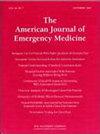Deficiency workflow: Utilizing electronic medical records to improve compliance with point-of-care ultrasound documentation
IF 2.7
3区 医学
Q1 EMERGENCY MEDICINE
引用次数: 0
Abstract
Background
Point-of-care ultrasound (POCUS) is a common modality utilized in emergency departments (EDs). Image acquisition and storage workflows have significantly improved. Saving POCUS images is considered standard of care. However, documentation compliance is a struggle for clinicians in the chaotic ED environment. We sought to implement a simple electronic medical record (EMR) deficiency workflow to improve capture of POCUS documentation and billing in a large healthcare setting.
Methods
A retrospective review of all POCUS studies across 12 EDs was performed from January 1 to December 31, 2023. All EDs utilized the same EMR with standardized workflow. Clinicians were recommended to complete charting within 48 h of patient disposition. A POCUS deficiency workflow was implemented on June 1, 2023 to improve compliance. Deficiency workflow was defined as automated in-basket messaging that appeared after POCUS order entry. Deficiency remained in the clinicians in-basket until procedure note was completed. We compared POCUS chart deficiencies for lack of procedural documentation. Descriptive statistics were performed.
Results
5013 POCUS were reviewed during the study period, 42 % before and 58 % after implementation. There was a 3.0 % absolute reduction (CI 2.01 %, 3.97 %) in procedure note deficiency from the pre-intervention to post-intervention period, 4.44 %. to 1.45 %.
Conclusion
A POCUS deficiency workflow improved documentation across our healthcare system. This directly improved billing of POCUS studies and decreased late chart notifications. This workflow can be implemented in any medical specialty that utilizes POCUS. We recommend large healthcare systems investigate similar workflows to improve documentation and billing of POCUS exams.
不足的工作流程:利用电子医疗记录来提高对护理点超声文件的依从性
背景:即时超声(POCUS)是急诊科(EDs)常用的一种方式。图像采集和存储工作流程有了显著改善。保存POCUS图像被认为是标准的护理。然而,在混乱的急诊科环境中,文档遵从性是临床医生的一个斗争。我们试图实现一个简单的电子医疗记录(EMR)缺陷工作流,以改进大型医疗保健环境中POCUS文档和计费的捕获。方法回顾性分析2023年1月1日至12月31日12例急症患者的POCUS研究。所有的急诊室都使用了相同的EMR和标准化的工作流程。建议临床医生在患者处置后48小时内完成制图。为了提高合规性,POCUS缺陷工作流程于2023年6月1日实施。缺陷工作流被定义为在POCUS订单输入后出现的自动收文篮消息传递。在完成手术记录之前,缺陷一直存在于临床医生的档案中。我们比较了POCUS图缺乏程序性文件的缺陷。进行描述性统计。结果在研究期间对5013例POCUS进行了审查,其中实施前和实施后分别占42%和58%。从干预前到干预后,程序说明缺失绝对减少3.0% (CI 2.01%, 3.97%),减少4.44%。到1.45%。结论POCUS缺陷工作流程改善了整个医疗系统的文档记录。这直接改善了POCUS研究的计费,减少了后期图表通知。该工作流可以在任何使用POCUS的医学专业中实现。我们建议大型医疗保健系统调查类似的工作流程,以改进POCUS检查的文档和计费。
本文章由计算机程序翻译,如有差异,请以英文原文为准。
求助全文
约1分钟内获得全文
求助全文
来源期刊
CiteScore
6.00
自引率
5.60%
发文量
730
审稿时长
42 days
期刊介绍:
A distinctive blend of practicality and scholarliness makes the American Journal of Emergency Medicine a key source for information on emergency medical care. Covering all activities concerned with emergency medicine, it is the journal to turn to for information to help increase the ability to understand, recognize and treat emergency conditions. Issues contain clinical articles, case reports, review articles, editorials, international notes, book reviews and more.

 求助内容:
求助内容: 应助结果提醒方式:
应助结果提醒方式:


